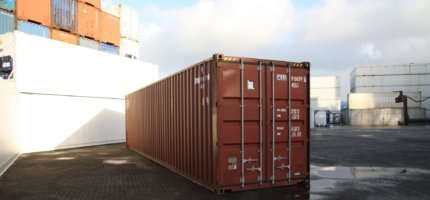Shipping containers, once the backbone of global trade, are increasingly being repurposed in creative and innovative ways. As the world embraces sustainability and resourcefulness, these robust steel boxes are being transformed into homes, offices, pop-up shops and more. This blog post delves into the fascinating world of second-hand shipping containers and their diverse applications, showcasing how these containers are reshaping our built environment.
The Appeal of Second-Hand Shipping Containers
The appeal of second-hand shipping containers lies in their durability, modularity and affordability. Made of corrugated steel, these containers are designed to withstand harsh oceanic conditions, making them extremely sturdy and long-lasting. Additionally, their standardized dimensions allow for easy stacking and modular construction, enabling versatile design possibilities. Finally, with millions of containers circulating globally, acquiring a second-hand unit is relatively affordable compared to traditional building materials.
Residential Housing: Affordable and Sustainable Living
One of the most popular uses for second-hand shipping containers is in residential housing. As housing costs rise and sustainability becomes a priority, container homes offer a cost-effective and eco-friendly alternative to conventional housing. These homes can be single-container units or multi-container structures, providing flexibility in design and size.
Tiny Homes: For those embracing the minimalist lifestyle, a single 20-foot container can be transformed into a cozy tiny home. With clever interior design, these compact spaces can include all the essentials: a sleeping area, kitchenette, bathroom and living space.
Multi-Container Homes: For larger living spaces, multiple containers can be combined to create expansive homes with multiple rooms, levels and even outdoor terraces. The modular nature of containers allows for unique architectural designs that are both functional and aesthetically pleasing.
Commercial Spaces: Versatile and Mobile Solutions
Second-hand shipping containers are also making waves in the commercial sector, where their portability and durability offer unique advantages for businesses.
Pop-Up Shops and Restaurants: Entrepreneurs are increasingly turning to shipping containers for pop-up shops and restaurants. These structures can be easily transported to different locations, making them ideal for temporary events, seasonal businesses, or testing new markets. Their industrial aesthetic also appeals to many brands looking for a modern, edgy look.
Office Spaces: With the rise of remote work and flexible office solutions, shipping containers are being converted into stylish and functional office spaces. These container offices can be standalone units or part of a larger complex, providing a quick and cost-effective solution for startups and small businesses.
Retail Spaces: Retailers are using containers to create unique shopping experiences. Modular and customizable, these containers can be designed to fit a brand’s specific needs, from boutique stores to expansive retail environments.
Educational and Community Facilities: Building Better Futures
Second-hand shipping containers are being used to construct educational and community facilities, providing accessible and affordable spaces for learning and social activities.
Schools and Classrooms: In regions where traditional construction is costly or impractical, shipping containers offer a viable alternative for building schools and classrooms. These container classrooms can be quickly assembled and customized to create conducive learning environments.
Community Centers: Shipping containers are being repurposed as community centers, offering spaces for social gatherings, workshops and recreational activities. Their adaptability allows for the creation of multifunctional spaces that can serve a variety of community needs.
Buy Shipping Containers – Reliable and Cost-Effective!
Need extra space? Purchase our premium, second-hand shipping containers. Perfect for storage, office spaces, or custom projects. Durable, secure, and budget-friendly. Get yours today and start building! Website: https://www.bbb.org/us/fl/tampa/profile/cargo-container/used-conex-llc-0653-90401137/customer-reviews
Emergency and Temporary Housing: Quick and Reliable Shelter
In times of crisis, shipping containers provide a quick and reliable solution for emergency and temporary housing.
Disaster Relief Housing: Following natural disasters, shipping containers can be rapidly deployed to provide temporary shelter for displaced individuals and families. Their sturdiness and ease of transport make them ideal for creating safe and secure living spaces in emergency situations.
Homeless Shelters: Shipping containers are being used to build shelters for the homeless, offering a dignified and secure living environment. These container shelters can be equipped with basic amenities and designed to provide privacy and comfort to those in need.
Artistic and Recreational Uses: Inspiring Creativity
The versatility of shipping containers extends to the arts and recreation, where they are being transformed into creative spaces and recreational facilities.
Art Studios and Galleries: Artists are converting shipping containers into studios and galleries, providing affordable and unique spaces to create and showcase their work. The industrial look of containers often complements contemporary art, adding to the appeal.
Sports and Recreational Facilities: Shipping containers are being used to build sports facilities, such as skate parks, climbing gyms, and fitness centers. Their modular design allows for easy assembly and customization, creating functional and engaging recreational spaces.
Environmental Impact: A Sustainable Building Solution
Repurposing second-hand shipping containers has significant environmental benefits, contributing to sustainability in several ways.
Recycling and Upcycling: Using second-hand containers for construction reduces the demand for new building materials, conserving natural resources and reducing waste. By giving these containers a second life, we prevent them from ending up in scrapyards or contributing to landfill waste.
Energy Efficiency: Shipping container buildings can be designed to be energy-efficient, incorporating features such as solar panels, green roofs, and efficient insulation. This reduces the environmental footprint of the building and promotes sustainable living.
Reducing Carbon Emissions: The modular and prefabricated nature of container construction minimizes on-site construction time and reduces carbon emissions associated with traditional building methods. Additionally, the ability to transport containers via existing shipping networks further lowers the environmental impact.
Conclusion: The Future of Second-Hand Shipping Containers
The innovative uses for second-hand shipping containers are vast and varied, demonstrating their potential to transform our built environment in sustainable and creative ways. From affordable housing and commercial spaces to educational facilities and emergency shelters, these robust steel boxes are proving to be a versatile and valuable resource.
As the world continues to prioritize sustainability and resourcefulness, the demand for second-hand shipping containers is likely to grow. Their durability, affordability and adaptability make them an ideal solution for a wide range of applications, offering a practical and eco-friendly alternative to traditional construction methods.
In the coming years, we can expect to see even more innovative uses for second-hand shipping containers, as architects, designers, and entrepreneurs continue to explore their potential. Whether it’s creating new homes, businesses, or community spaces, these repurposed containers are set to play a crucial role in shaping a more sustainable and resilient future.











